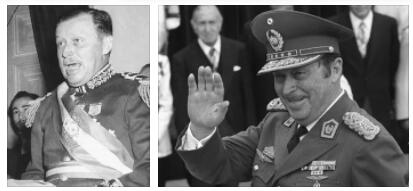History of Paraguay until independence
The first residents
It is proven that around 9000 BC BC people lived in what is now Paraguay. Over time, various indigenous peoples were formed. The Aché Indians are considered the descendants of the indigenous people. Around 500 BC The agricultural Guaraní came from the north, from the Amazon region, and displaced the Aché. They grew cassava, corn, and peanuts. Between the 13th and 16th centuries the Guaycurú then migrated from the south to the north and got into a dispute with the Guaraní.
Conquest by the Spaniards (16th century)
In 1516 the first European came to what is now Paraguay: Juan Díaz de Solis sailed up the Paraná river. He and most of his men were killed by Indians. In 1527, Sebastiano Caboto founded a station.
In 1537 the Spaniard Juan de Salazar y Espinosa founded the fortress Asunción, which slowly became a settlement and finally a city. The area between the Río Paraguay and Río Paraná was conquered in several campaigns.
Spanish colony
In 1542 the Spaniards founded the Viceroyalty of Peru, which initially comprised almost all of South America. Paraguay was one of them. The Spanish conquerors forced the Indians to work on their estates. Many Indians also died from diseases that the whites had brought in and against which they had no defenses, for example the flu or measles. The Indians rose up against Spanish rule several times, but without success. In 1588 the Jesuits began to evangelize the Indians.
The Jesuit Reductions (1609-1767)
In 1609 the Jesuits began to bring the indigenous population together in special settlements. These were called Jesuit reductions. On the one hand, the Jesuits wanted to protect the Indians from the arbitrariness of the Spanish conquerors, for example from slave hunters and from the large landowners who forced the Indians to work on their plantations.
On the other hand, their goal was to convert the Indians, to proselytize them. This mission was based on the simultaneous recognition of the culture of the Indians. Many of these settlements arose in an area that today belongs to the countries of Paraguay, Argentina and Brazil, there were 30 reductions among the Guaraní alone. Many Indians sought protection in the reductions. Spaniards were not allowed to enter the reductions.
These village communities were economically very successful, especially in agriculture and handicrafts – far more successful than the Spanish settlements. This led to resentment among the Spaniards. In addition, the attitude of the Jesuits towards the Indians did not correspond to the attitude of the Spanish colonial masters.
There were repeated attacks on the reductions. In 1767 the Spanish king finally expelled the Jesuits and dissolved the reductions. With the confiscated property the Spaniards hoped for rich income, but that turned out to be wrong. The reductions fell apart.
Part of the Viceroyalty of Río de la Plata
In 1717, the north of South America was split off as the viceroyalty of New Granada (today Colombia, Panama, Ecuador and Venezuela) in order to better manage the large colony. In 1776 the south was also separated. Paraguay no longer belonged to Peru, but with Bolivia, Uruguay and Argentina to the viceroyalty of Río de la Plata.
Independence (1811)
The struggle for independence began throughout Latin America around 1800. On May 14, 1811 Paraguay declared its independence. In 1814 José Rodríguez de Francia prevailed in the struggle for power and ruled the country as dictator until his death in 1840. He sealed off Paraguay. Paraguay became economically successful. Francias nephew Carlos López ruled from 1844 to 1862 and greatly strengthened the military. Then his son Francisco López followed until 1870. He continued to arm and pursued the plan to conquer the country. In 1864 he declared war on Argentina and Brazil.
History of Paraguay from the 19th century to the present day
Triple Alliance War (Paraguay War, 1865-1870)
Argentina and Brazil formed an alliance with Uruguay against Paraguay. The alliance is also known as the Triple Alliance, “Alliance of Three”. Paraguay lost half of its country and a large part of its population in this war, because around 300,000 people died (and again as many on the other side). Paraguay lost its economic supremacy.
Unstable republic
Between 1870 and 1954 Paraguay was ruled by 44 men. Of these, 24 took power through a military coup.
Chaco War (1932-1935)
In the Chaco War Paraguay fought against Bolivia for areas in the Chaco. Oil was discovered there in 1928. Paraguay won and thus secured land.
Dictatorship under Alfredo Stroessner (1954-1989)
After the political situation was still unstable and conservative forces of the Colorado party and liberal supporters fought again and again, Alfredo Stroessner took power in 1954. He was a member of the Colorado Party. Stroessner’s father was a German who had emigrated to Paraguay. His mother was from Paraguay. He ruled dictatorially for 35 years. Political opponents, especially communists, were persecuted and murdered. Many fled abroad.
Return to democracy in 1989
Andres Rodríguez finally overthrew Stroessner and initiated democratic change. Stroessner fled to Brazil. In 1991 Argentina, Brazil, Paraguay and Uruguay formed Mercosur, an economic alliance. In 1992 there was a new democratic constitution.
The first free elections in 1993 were won by Juan Carlos Wasmosy. Since then, members of the Colorado Party have predominantly governed, only between 2008 and 2013 that was not the case. In 2008, Bishop Fernando Lugo won the elections. He was held responsible for a violent confrontation between police officers and land occupiers in 2012 and was dismissed from office. The 2013 election was won by Horacio Cartes of the Colorado Party. In 2018 he was replaced by Mario Abdo Banítez. He is also a member of the Colorado Party.
